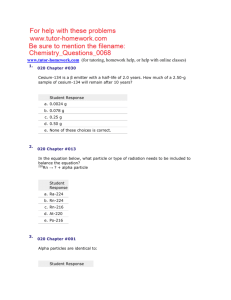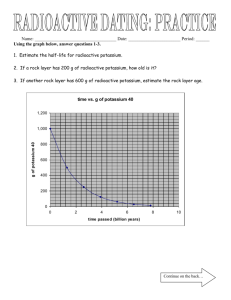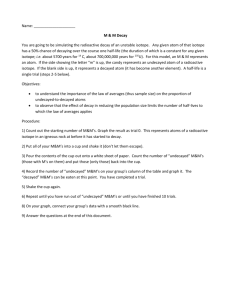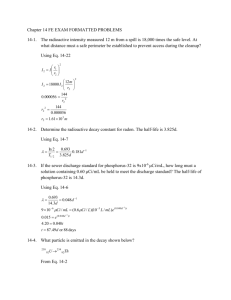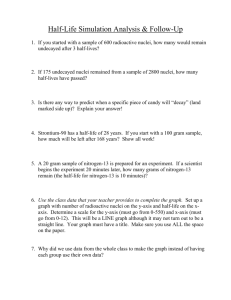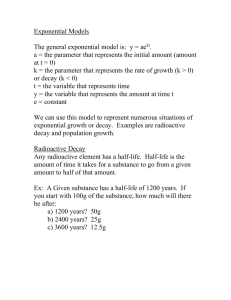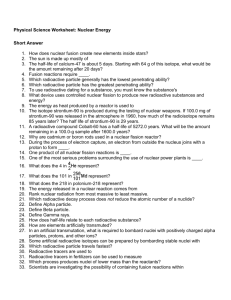Nuclear Chemistry
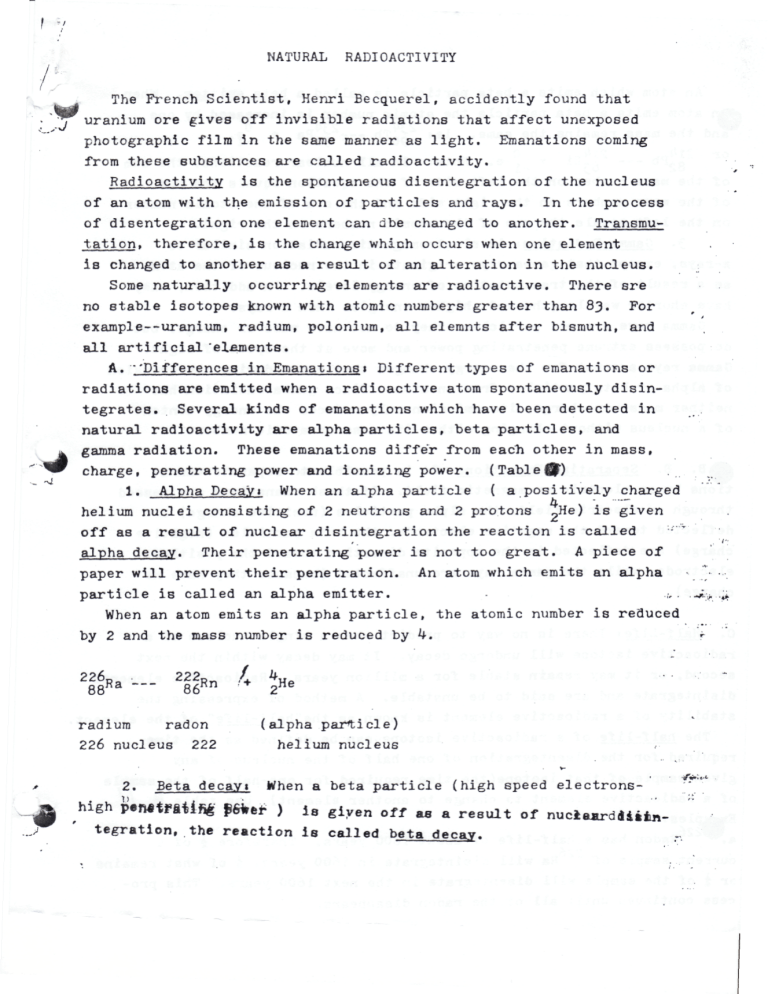
NATURAL RADIOACTIVITY
••_ "J-
The French Scientist, Henri Becquerel, accidently found that uranium ore gives off invisible radiations that affect unexposed photographic film in the same manner as light. Emanations coming from these substances are called radioactivity.
Radioactivity is the spontaneous disentegration of the nucleus of an atom with the emission of particles and rays. In the process of disentegration one element can dbe changed to another. Transmutation, therefore, is the change which occurs when one element is changed to another as a result of an alteration in the nucleus.
Some naturally occurring elements are radioactive. There sre no stable isotopes known with atomic numbers greater than 83. For example--uranium, radium, polonium, all elemnts after bismuth, and all artificial"elements.
A. "Differences in Emanations» Different types of emanations or radiations are emitted when a radioactive atom spontaneously disintegrates. Several kinds of emanations which have been detected in natural radioactivity are alpha particles, beta particles, and gamma radiation. These emanations differ from each other in mass, charge, penetrating power and ionizing power. (Table0")
1. Alpha Decay» When an alpha particle ( a positively charged helium nuclei consisting of 2 neutrons and 2 protons
2
^ e
^ * s
£i ven off as a result of nuclear disintegration the reaction is called alpha decay. Their penetrating power is not too great. A piece of paper will prevent their penetration. An atom which emits an alpha particle is called an alpha emitter.
When an atom emits an alpha particle, the atomic number is reduced by 2 and the mass number is reduced by ^-.
226
Ra
222
R
f 4
H
88
Ra •
86
Rn
2
He radium radon (alpha particle)
226 nucleus 222 helium nucleus
2. Beta decay.! When a beta particle (high speed electrons-
p.MtFflUf* ffiW ) ie giyen off as a result of nucia*rdai*imtegration, the reaction is called beta decay.
An atom which emits a beta particle is called a beta emitter. When atom emits a beta particle the atomic number is increased by one
2*3/1 23^ 0 and the mass remains the same, iei on^^ --- Ql^ a
* -f* opPb --- 83"^ * -1
e
* Note i ^ n
all nuclear reactions, the sum of the mass number on the left side of the equation equals the sum of the mass numbers on the right side and the. sum of the atomic number on the left equals the sum of the atomic numbers on the right.
3- Gamma Radiatiom is electromagnetic radiation similar to x-rays, except that gamma rays originate in the nucleus of the atom as a result of the transmutation of energy levels. In addition, they have shorter wavelengths and ..higher energies than x-rays.
Gamma rays are not particles — they do not have mass or charge, but do possess extreme penetrating power and move at the speed of light.
Gamma rays account for the energy changes that occur during the emission of alpha or beta particles from an atom. Since gamma radiation has neither mass nor charge, its emission only reduces the energy content of a nucleus without changing either its mass or atomic number.
t B. B. Separating Emanations! It is possible to separate emanains by an electric or magnetic field. If these emanations are passed through an electric field, the alpha particles (positive charge) are deflected toward the negative electrode, the beta particles (negative charge) are 'deflected in the opposite direction toward the positive electrode, while the gamma rays are unaffected (because they have no charge).
C. Half-Life i There is no way to predict when a single nucleus of a radioactive isotope will undergo decay. It may decay within the next second, or it may remain stable for a million years. Radioactive elements disintegrate and are said to be unstable. A method of expressing the stability of a radioactive element is known as the "half -life" of the element.
The half-life of a radioactive isotope can be defined as the time required for the disentegration of one half of the nucleus of any given sample of that isotope(the time required for one-half of the sample of a radioactive element t> change to another element) Use table ftl A/
* w
Pp p A
' Radon has a half-life of about 1600 years. Therefore i of a r\ O/C current sample of ' Ra will disintegrate in 1600 years, i of what remains or i of the sample will disentegrate in the next 1600 years. This process continues until all of the radon disappears.
p.-s b. Co is 5«3 years, i remains after 5-3 years, i after 10.6
years. The process continues indefinitely.
The'r&te at which the nucleus disintegrates or its half-life, is a measure of its stability. Half-lives of isotopes may vary from three
212 9 ten millionths of a second for ' Polonium to 4.51 x 10
7
year for
2
38
Ur
__ ( more
stable)
Problems t If the half-life of an isotope is represented by T, then the fraction of a sample that remains after time t isi
Fraction remaining « (i) ' , where t/T is the number of half-life periods that have elapsed
111
1. What mass of
J
I remains 32 days after a 100 gram sample of this isotope is obtained?
solutioni Method -11 Reduce the mass by one-half for each succesive half-life period until the total time is r e a c h e d i Find the half-life on table F--8.0? days.
After 8 days ! of 100,,g or 50 g will remain
After 16 days ! of 50 g*. & or 25 g will remain.
After 24 days ! of 25 g or 12.5 g will remain
After 32 days £ of 12.5 g or 6.25 g will remain.
Method 2i Divide the total time by the half-life to find the number of half-life periods. Then use the formula--
Fraction of isotope remains « (i) ' * t/T= 32/8 (!) « 1/16 Fraction remaining
1/16 x lOOg = 6.25 g
»--
D. Determining the Age of Substances by Natural Radioactivity! It is possible to calculate the age of a substance if facts are known concerning the amount of a specific radioactive isotope present in the substance
14 and its half-life, For examples xCarbon is employed to date objects of organic origin. In living things, while they are alive the presence of radioactive C in the organism is kept at alow but constant level. The C originates from
7
N present in the atmosphere. The
N are bombarded by cosmic rays to produce C atoms
A find their way into the living organism.
When a plant or animal dies,
1
^C which has a half-life of 57^0 yrs is no longer kept at a constant level, but slowly diminishes with time.
It is possible to determinathe age of such substances as old wood, various objects taken from old tombs and other historic objects, by the amount of 14C currently present in an object.
Problemi Analysis of, charred wood at a prehistoric caapsite reveals \ that it contains the equivalent of only i of the quantity of C that is found in living wood tissue. If the half life of C is
5,720 years, how old is the campsite.
solutioni Since C is reduced to i after One half life period and to i after the second half life period. Therefore two half-life periods must have elapsed. Age of campsite- 2 x 577,0* li^K) years.
$ half K r.
. « , i ..'^ k t *
fon
^Oc| vi
-I/
,
*
#
<?
3*-
•l..
•
Radiation
Cless
Identify each of the three beams of radiation in the figure as
alpha, beta, or gamma radiation. Then state the charge of each
beom, and give the reason for your answer. .Also state what type
of partich or electromagnetic radiation makes up each of the beams.
Radioactive sample
Positive plate Screen
1 fl .
Dete lead block
Negative plate
Beam
Number
1
2
3
Type of
Radiation
(a)
(a)
(a)
Charge
(b)
(b)
(b)
Reason
(c)
(c)
(0
Particle or
Radiation
(d)
(d)
(d) b.
c.
d.
b.
c.
1
13-8
Activity
Nuclear Chemistry Worksheet
(I) Write a balanced equation for the alpha decay of each of the following:
(II) Write a balanced equation for the beta decay of each of the following:
1) Uranium-238 1) Uranium-238
2) Radium-226
3) Polonium-214
4) Thorium-234
5) Lead-214
2) Radium-226
3) Polonium-214
4) Thorium-234
5) Lead-214
(III) Complete the following equations:
1) 86
Rn'
222 a +
2)
84
Po
210
3) 83 Bi
214
+ ,H
1
-» a +
4)
-r-» u
+
O n
5) nNa
24 a +
!U
r
Cii:AR DICAY
Nome
Predict the products of the following nuclear reactions.
c
2.
3.
4. JH
5. *Li -»• in -
42
He
6. ?
37
AI -H JHe 30p
15 r
7.
94
Be + JH
8.
37
K — ?e
9.
10.
Chemistry IF8766 34
t?ALMJFE OF
ISCTOPIS
Nome
How much of a 100.0 g sample of
198
Au is left after 8.10 days if its half-life is
2.70 days?
_
2 A 50.0 g sample of "N decays to 12.5 g in 14.4 seconds. What is its half-life?
3 The half-life of
42
K is 12,4 hours. How much of a 750 g sample is left after 62.0 hours?
4. What is the half-life of "Tc if a 500 g sample decays to 62.5 g in 639,000 years?
i
-
r
^Q half-life of
232
Th is 1.4 x 10'° years. If there are 25.0 g of the sample left after
2 8 x 10'° years, how many grams were in the original sample?
\)
•ei . are 5.0 g of
I31 l left after 40.35 days. How many grams were in the original
,f ,ts half-life is 8.07 days?
c
Half-Life is defined as the time it takes for 50% of a radioisotope to transmute into a new element.
Therefore, after successive half-life periods, the amount of radioisotope remaining is half the amount at the start of that period.
start
1
1
*-half-life periods-*
2
\5
4 5
1/2 1/4 1/8 1/16 1/32
1) What part of any given sample of a radioactive isotope remains after 6 half-life periods?
2) The half life of Polonium-218 is 3 minutes. Starting with a 10 gram sample, how much will remain after 9 minutes?
3) The half life of Bismuth-210 is 5 days. Starting with 100 grams of this radioisotope, how much will remain after 30 days?
4) If 6.25 grams of an original 50 gram sample of a radioisotope remains after
40 minutes, then what is the half-life of this radioisotope?
5) If 3 grams of a radioisotope, with a half life of 4 hours, remains after 24 hours, then what was the mass of the original sample of this radioisotope?
Nuclear Chemistry
A. Natural Radtoactiviry-
1 Radioactive isotopes or radioisotopes • unstable isotopes that continually emit alpha or beta panicles, and gamma radiation a changes the NUCLEUS, thereby changing the ELEMENT - this is called transmutation.
b nuclear reaction - involves changes in the nuclei of atoms ex 1: % U -> ^Th + }He ex 2: Th -> *Pa +-°,e
"^ txupwtid* uMUbU * ibo bmlu down • radKMCUvc term.
c.
a neutron in a nucleus can emit an electron and change to a proton
<in -» 1 H +.° v e pnaco
B. Artificial Radioactivity (lad.ced Radioactivity) l Elements can be made radioactive by bombarding their nuclei with high energy particles such as protons, neutrons, and alpha particles.
ex. 1: 1|N + ^He -> '^O + {H RuAedwd'i tipk* portid* proloa
2 Irene Jol tot-Curie studied the effects of alpha particle bombardment on some light elements.
3 Radioisotopes are produced from stable isotopes of the same element An element can be bombarded with a neutron and become radioactive ex 1: > + »NI->
2
,;Na ex. 2: ^n + ^Cl -+ a. important uses in medical diagnosis and treatment, geology, biochemistry, and agriculture
I paths can be traced by a Geiger counter as it moves through a living thing into which h has been placed a tracer - a radioisotope whose movements are followed, b some examples to remember
1 Radium and Cobah • 60 are used in cancer therapy
2 Technetium - 99 is used to locate brain tumors
3 Iodine - 131 is used to diagnose thyroid disorders
C Radioactive Datiof • determining the ages of rocks and in dating relics and past events
1 ratio of uranium -238 / lead - 206 in a mineral can be used to determine the age of the mineral
2 ratio of carbon-14 in a sample to that in the atmosphere, is used to determine the age of a sample
1 Half-life - time required for a radioactive sample to decay to half its original mass It is not affected by temp or pressure transmutation ex.
1: Suppose you have a sample containing 800 nuclei of a radioactive isotope If after one hour only 50 of the original nuclei remain, what is the half-life of this isotope
9
ex. 2: You hive 400mg of a radiouotope with a half-life of five minutes. How much will be left after 30 minutes?
Problems:
What kind of reaction is this
9
What kind of reaction is this
9
What kind of reaction is this
9
Name the type of radioactive radiation in each of the following: a An isotope of iodine undergoes radioactive decay to form an isotope of xenon that has a higher atomic number but the same mass number as the iodine b Technethim - 99 undergoes radioactive decay but both its atomic number and mass number remains the same.
c An isotope ofthorium undergoes radioactive decay to form an isotope of radium that has a lower atomic number and mass number
C Nuclear Pinion "splitting"
1 splits an atom of large mass into 1 or 2 elements of lesser mass - 2 or more neutrons
2 releases large amounts of energy E = me
2
3 the "new" elements formed are more stable
4 the neutrons that are released bombard other nuclei producing a chain reaction
5 Fission RwtPf controls the nuclear splitting so the energy can be captured and used
Concrete
Stum gmtritor
.r
PJULTS OF A ftUCLBA* FZSSZOV KBJLCTOft
Fuel - miit be • fiaaionabl* iaotope
Ex.
* » » u - found in nature but not plentiful
» » » U - made from •••Th in • breeder reector
•••Pu - made from •••U in • breeder reector
Moderator - a material that alow* down neutron* 'without •topping them »o they can N. *i»*rv<4 fry the c0ntr*ln»4s ftAjjfiiriM fti
Ex. water, heavy water CHaO), beryllium, graphite
Control rode control the chain reaction by absorbing neutron*
Ex. boron, cadaiua
Coolant keep* teaperaturee at reaaonable level*
Ex. water, heavy water, air, carbon dioxide
Shielding provide* protection from radiation
• Ex. ateel inaide, concrete outaide
Breeder reactor - produce* uaable fuel* from nonfiaaionable iaotope* by artificial tranamutation
Radioactive waate* - *olid* and liquid* are atored
in
container*
underground* at the reactor aita
***** mrm «t-or«d In chamber* until they decay
w o ' o H g h l nuclei combine to form a s.ngle
nucleus of .lightly less total mass a the difference in mass is convened to energy E = me b more energy than in a fission reaction
•> fuds hydrogen isotopes ?H
(deuterium) and ,H (tntium)
3 High Energy Requ.rement
- nucle, repel each other as they are moved close together High K E to overcome repuls.on
= very high temps 20m C a thermonuclear devices - bombs based on fusion react.ons
b fusion reactors - problem in development due to extremely high temps
.r
,
Ntme
— Gass Date.
Activity 1O-2
Artificial Radioactivity
Induced radioactivity
1 . Choose words from the word list to fill in the blanks in the following paragraph relating to artificial radioactivity.
Words that have contrasting or related meanings have been paired.
Word List artificial/natural neutrons/protons bombarded stable/unstable existing/new transmutation
Stable nuclei can be converted to _ , hence radioactive, nuclei.
Bombardment of stable nuclei with particles such ax _ , _ , and alpha particles produces unstable nuclei.
For instance, when beryllium-9 is bombarded by _ the following transmutation takes place:
Ile+iH-iU+!Ht
Such bombardment can produce _ elements as well as various isotopes of - elements. All transuranium elements have been produced by the bombardment of existing natural or artificial isotopes.
For example, when uranium-238 is _ by an alpha particle the _ element plutonium-240 is produced:
Uses of radloisotopes
2. What is a radioactive tracer?
3. Give an example of the use of a radioactive tracer in: a.
Medicine b. Research c. Industry
4. How is radioactive cobalt (Co-60) used for cancer therapy?.
5. How are radioisotopes used for food preservation?
6. How is radioactive carbon (C-14) used to date archeological f i n d i n g s ?
Nuclear reactors
7. Name three fissionable isotopes used as fuels in nuclear reactors.
8. What is a breeder reactor?
For each of the following components of a nuclear reactor, describe its use and then list one or more substances that are used in the component.
9. Moderators. Use:
Substance(s):_
10. Control rods. Use:
Substance(s):.
11.
Coolants.
Use:
Substances):
12.
Shielding.
Use:
Substances):.
Particle accelerators
13. Choose words from the word list to fill in the blanks in the following paragraph related to particle accelerators.
Word List beams linear accelerator bombarded energy cyclotron synchrotron
Artificial transmutations result when target nuclei are by high particles. Particle accelerators are used tp produce of such high particles.
The and accelerate charged particles in circular paths by use of electromagnetic fields. The uses synchronized fields of electric force to accelerate positively charged particles.
Narr.e Gass Daie.
Nuclear energy—fission
U. Choose words from the word list to fill in the blanks in the following paragraphs relating to nuclear fission. Words with contrasting or related meanings have been paired in the list.
Word List cnain
neutrons controlled/uncontrolled stable/unstable energy
Fission occurs when nuclei with high atomic numbers capture This process produces fission fragments and __ while releasing two or more neutrons.
The energy produced is the result of conversion of mass into according to the Einstein formula:
£ = me*
The release of additional causes the buildup of a chain reaction. The elements formed as fission fragments are more than the original heavier nucleus because they have greater binding energy per nucleon. The energy produced in an atomic bomb blast results from an uncontrolled chain reaction.
This same reaction is carried out under conditions in a nuclear reactor.
15.
Why is the disposal of radioactive wastes a special problem?
Learn about and describe one or more methods used or suggested for their disposal.
Nuclear fusion
16. Define nuclear fusion.
17. The energy produced by nuclear fusion is (greater/less) thari the energy produced by a fission reaction.
18. What is the source of energy in a nuclear fusion reaction? — •
19. What fusion reaction is probably the source of solar energy?
20. What is the purpose of the fission reaction in a thermonuclear device?.
21.
What isotopes of hydrogen are used as fuels in fusion reactions in thermonuclear devices?


